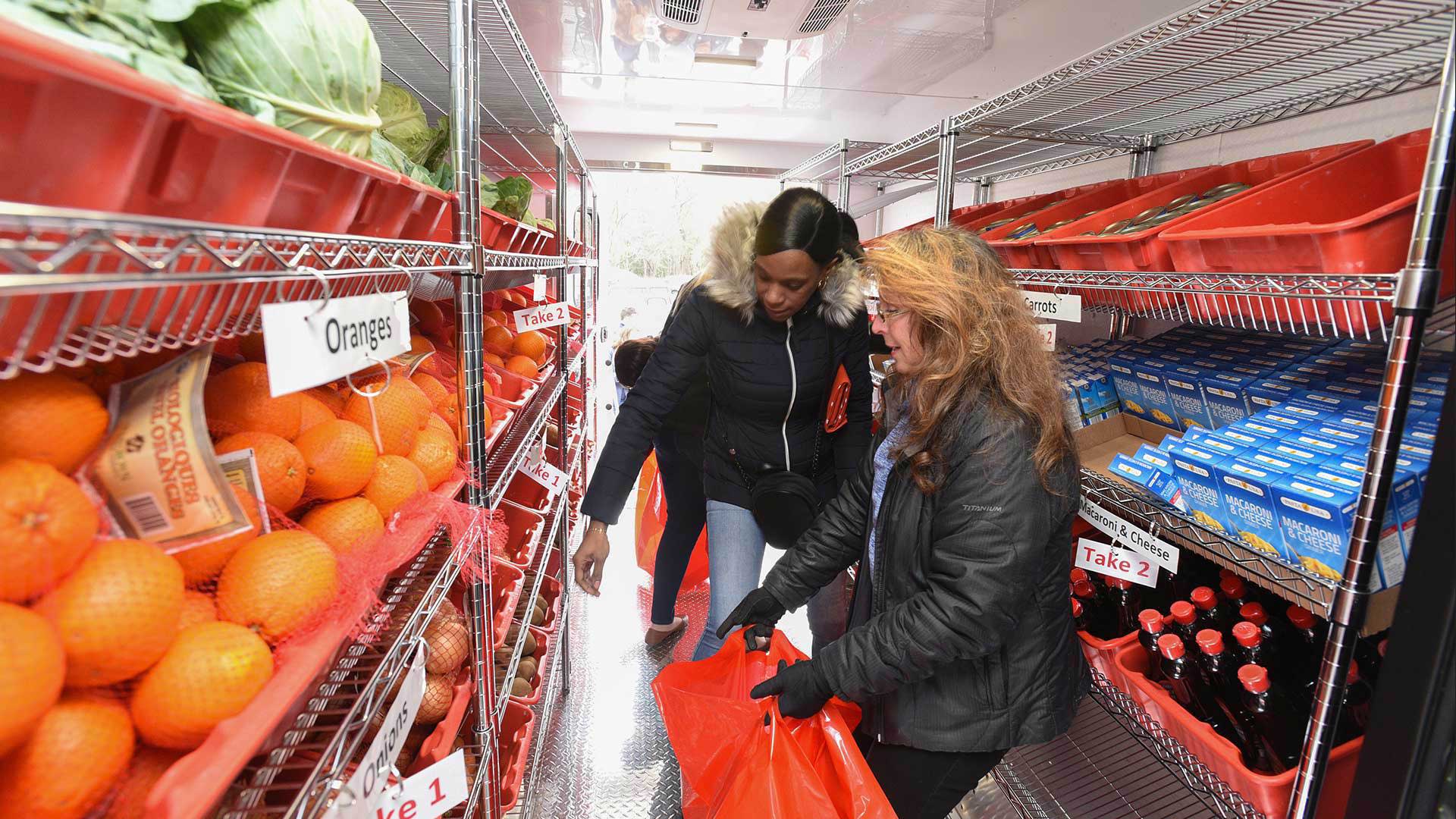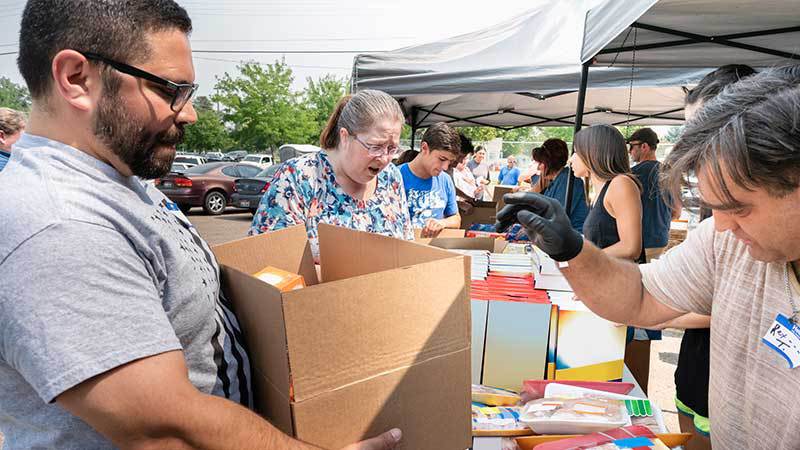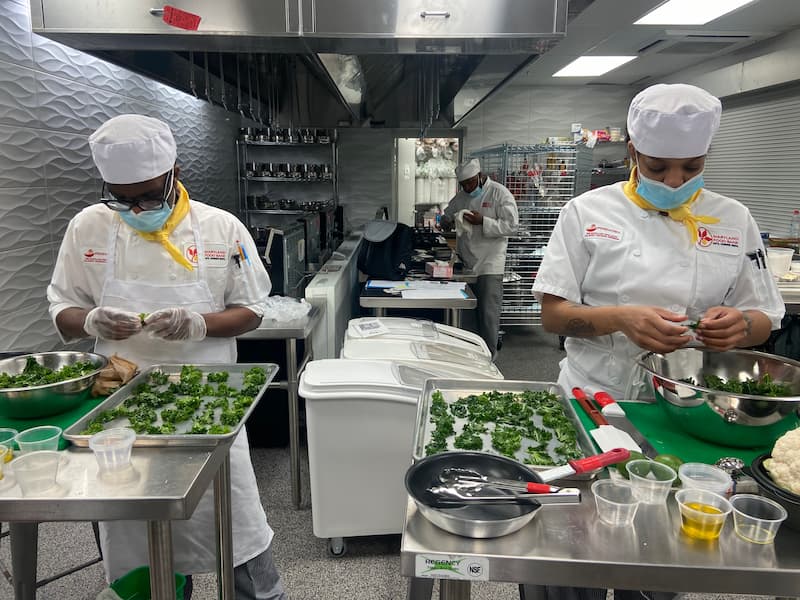A New Strategic Direction for the Maryland Food Bank

Can you envision a Maryland where children don’t struggle to learn, working families no longer juggle managing bills, older adults aren’t hampered by limited mobility, and people in Communities of Color can overcome institutional barriers to food security? We can.
For too long, hunger has weakened our state’s ability to excel. Our work ahead is not going to be easy, and we know it’s not going to happen overnight.
We have a refreshed and an enhanced strategic plan, and we’re going to realize this vision for a stronger Maryland, together.
Planning a Brighter Future for Maryland
The last time there were significantly high rates of hunger was following the Great Recession (from 2007 to 2009), and it took nearly a decade before food assistance reverted to pre-Recession levels.
It’s now fall 2021, just a few months after COVID-19 vaccines were made widely available. Our state has started the process of recovery, but approximately two million Marylanders may still face hunger this year.

The Maryland Food Bank is the only statewide resource devoted to ending hunger, and we know it is going to take years of sustained work to help our neighbors in need get through this.
We are a powerful hunger-relief organization, operating at twice the volume than before COVID. In fact, between March 2020 and June 2021, we distributed more than 66 million meals.
Our pandemic response taught us that the food bank’s safety net can withstand a crisis only with the support of donors like you. Now is the time for us to do even more, and we’re ready for that challenge.
“We’ve taken our pre-pandemic efforts, applied the lessons we learned during COVID, and emerged stronger with a revitalized strategic plan that expands food access and creates pathways out of hunger. However, we realize those efforts will only be possible if we first invest in our own sustainability and growth.”
And with so much at stake as Maryland rebuilds, Del Guercio felt it was critical to establish a team dedicated to helping map out the future of the organization. Led by MFB veteran Meg Kimmel, this new Strategy Group will help ensure our plan has the maximum impact on our neighbors in need.
Take a deeper dive into our Strategy Group in this Q&A with MFB’s EVP & Chief Strategy Officer Meg Kimmel
Expanding Food Access, Touching More Lives
The first pillar of our strategic plan focuses on increasing access to nutritious food, while operating as cooperatively as possible — and that begins with our internal operations.
Sourcing, managing, and distributing enough food to provide more than 66 million meals from multiple locations requires staff and systems to work in concert. We’re distributing much higher volumes of food and tripled our inventory — from roughly three million pounds to nearly nine million pounds on any given day.
From Local Farm to Table
We have strengthened Maryland’s food system through our successful Farm to Food Bank program for over 10 years, but we want to make it even more sustainable and efficient by purchasing more food from local growers.
Community gardens are a great way to increase food security and help residents understand the importance of a strong local food system, which can lead to healthier choices. They also provide opportunities for building community engagement and deepening neighborhood relationships through volunteering and other activities.
“We’re committing to intentionally purchasing from urban farms and local vendors. This shift further shortens the distance between food producers and consumers, and helps diverse communities access high quality, healthy foods,” Kimmel explained.

Mapping Out Hunger Solutions
Just prior to COVID, we launched our Maryland Hunger Map, which combined publicly available information from organizations like the United Way, as well as localized data to give us a more accurate picture of hunger in our state. We recently upgraded the map with new, timely data sources featuring additional demographic, socio-economic, and geographic information.
This tool will allow us to help shape our distribution efforts to provide highly targeted solutions that meet the needs of underserved communities, eliminating “hunger hotspots.”
“Fortune 500 companies use data to better understand the needs of their customers, so they can offer products that solve a particular need. So why shouldn’t a nonprofit like the Maryland Food Bank use the same principles to make a greater impact on the lives of our neighbors in need?”
In addition to the information available in the Maryland Hunger Map, we’re excited about expanding the use of Link2Feed software throughout our partner network. Link2Feed data will provide us with even more key client demographics and trends such as the number of clients served and the frequency of client pantry visits. This data will also help our Programs team determine where adjustments to service interventions may be needed.
“This data will build on the collective expertise of our Programs staff and Network Partners, allowing us to analyze data to more holistically understand where and how clients are accessing our programs, define and evaluate outcomes, and maximize the impact of our services,” said Kimmel.
Beyond Food: Creating Pathways out of Hunger
While we’re excited to see how distributing more nutritious food in the right places lifts our state, we know that “shortening the line” for more Marylanders will require more than food. The second pillar of our strategic plan focuses on providing additional opportunities for our neighbors in need by addressing root causes and widening pathways out of hunger.
As you read about in the June 2021 newsletter, we’re dramatically expanding our already successful FoodWorks culinary training program by adding more capacity at our Halethorpe facility and operating a second location at the UA House in Baltimore City.

These efforts will more than double the opportunities for Marylanders seeking to transform themselves into professional chefs, the vast majority of whom earn significantly higher than minimum wage.
“FoodWorks was finally a positive step in the right direction after turning the wrong way for a very long time. The program has reminded me every day that I am smart, I am kind, I am resourceful, and as of today, I am officially successful!”
We realize that the life-changing opportunities that FoodWorks provides are not suitable for everyone, so we’re working to develop more partnerships, strategically linking Network Partners with local social services that can help provide the appropriate assistance (educational, financial, healthcare, etc.) to meet the needs of their communities.
Some of our partners, such as Haven Ministries in southeastern Queen Anne’s County (see story on back cover), are already leading by example, offering more than food, and providing financial literacy training (as a requirement of utility assistance), clothing, furniture, and transportation assistance.
By delivering more wraparound services, we can offer holistic solutions to help more Marylanders sustain healthy, active lives.
Investing in the Food Bank Today for a Better Maryland Tomorrow
The Maryland Food Bank’s ability to improve the lives of our fellow Marylanders through the first two pillars of our strategic plan must be based on a solid foundation of infrastructure, data, resources, and innovation.
This third pillar of work, which emphasizes organizational sustainability and growth, will make that possible. And we have the staff in place to bring it to fruition.
Over the last year and a half, we were proud to give our all and be there for our neighbors in need. But serving as frontline workers over such a long period of time has taken a toll.
We know the road ahead to Maryland’s recovery is long, so we’re continuing to put in the work through a conscious focus on self-care, training, and professional development to make sure we are recharged, refreshed, and ready to be the food bank that Maryland needs us to be.
“We have always been an outward-facing organization, preferring to prioritize the needs of our partners and clients over our own,” Kimmel said. “In a recent conversation, a long-time MFB donor and trusted advisor encouraged me to think differently. She told me, ‘If the food bank doesn’t spend time and energy to increase its own readiness, guess what… you won’t be ready! And we all need you to be ready!’”
To really understand and provide for the needs of Maryland’s diverse population, a workforce that looks through the lens of racial equity and thoughtfully applies inclusive solutions is required, especially when considering outcomes for the Communities of Color and vulnerable persons that continue to remain trapped in generational cycles of poverty.
We are providing Diversity, Equity, and Inclusion training to all food bank staff; developing and publishing a racial equity statement; and ensuring our messaging, partnerships, and programs are reflective of this viewpoint.
Additionally, we’re continuing to improve processes, leverage technology, and automate where sensible to ensure our staff is well-positioned to successfully execute the strategic plan.
And to make sure these strategies are achieving maximum impact, we’ll apply key performance indicators to programs and processes; regularly review data and trends; and redirect our efforts as needed.
Our ability to continue expanding access to nutritious food while simultaneously building more pathways out of hunger will require MFB to increase our financial resources by nearly a third.
We were humbled by the outpouring of donations of time, talent, and financial support throughout the chaos of COVID. Without them, we never would have been able to provide relief to so many Marylanders.
We hope we can count on your continued partnership and support to make Maryland a better state for all.
Strategy Group Q&A with Meg Kimmel
Learn more about the new Strategy Group in this interview with MFB veteran Meg Kimmel, who is leading this team, ensuring our plan has the maximum impact on our neighbors in need.
QUESTION: Why was the MFB’s Strategy Group created?
MEG KIMMEL: We had about 18 months of good, solid time working on our strategic plan before the pandemic hit and we are proud of those early results.
Coming back to the plan after COVID, and with new learnings, we decided to try something different. It was clear that unless we reorganized to support our refreshed strategy, we wouldn’t have the impact we wanted. So, we formed the Strategy Group to put ourselves in an even stronger position to translate strategy into results.
We are just now emerging from a year and a half in which MFB dedicated all its time, talent, and resources to serve as the state’s primary COVID-19 emergency food response partner. The pandemic has vastly expanded food insecurity, and based on our own estimates, roughly 1 in 3 individuals may face hunger in the coming year.
Those projections are genuinely alarming… to us, too. Unfortunately, this level of food insecurity is not something that we can ‘food bank’ our way out of. The charitable food system was never designed to be a stand-alone entity, so the road ahead will require new ideas and innovative partnerships — both public and private.
While we understand and value the importance of providing food, we also know that it will take more than food to end hunger. We must address the underlying issues that cause food insecurity in the first place. Food insecurity is often caused by a lack of financial resources, but it can also be a symptom of unstable housing, chronic disease, or limited access to transportation, just to name a few.
So, to re-orient ourselves to a post-pandemic Maryland, we updated our 2018 Strategic Plan this past spring to make sure it holds our best ideas and that it’s relevant for the coming years.
Another thing to know about the Strategy Group… it is designed to be an ‘idea incubator’ where new approaches get the support they need to succeed, and if we fail, we fail fast and with minimum impact.
And, after the crazy chaos of this past year, we are all fully engaged in new work and committed to agility and learning, so that lines up well with the timing of our launch, too.
Q: With two million Marylanders facing hunger, isn’t there enough work for the food bank to be doing now?
MK: The fact that there are 2 million people potentially facing hunger in Maryland IS the reason the time is right.
Our core work – getting food to people who need it – is something that we are very good at. In fact, we’re even better at it today than we were before the pandemic, and so are our statewide distribution partners. Last year, we worked more closely with our network than ever before. We have a clear idea of how much we can accomplish and where there are gaps.
There are vulnerable populations — like older adults and the newly unemployed — who have different needs. So, we are focusing our programming on reaching people at home and helping more Marylanders get back to work, and more.
This is more difficult work, requiring program strategy to keep pace with an ever-changing situation on the ground, in communities across the state. The Strategy Group offers support — technology, partnerships, data, expertise, and more — to this work.
Q: What are some specific projects the group is working on?
MK: Many of the things that you’ll read about in this issue have come through the Strategy Group. The Maryland Hunger Map (see page 7) is a great example of how we are leveraging technology to make it easier to deliver more targeted programming.
Another example is a new Feeding America app we’re testing called OrderAhead. MFB is one of 11 food banks testing the product, nationwide. We’re excited about it because OrderAhead offers some important features and functions. First, it allows people to choose the food they want. (MFB now has four different versions of our Back Up Box to choose from: Latin Communities, Older Adults, Diabetes-friendly, and the standard Healthy box). Second, it allows people in need of food to order anonymously. This is key as research shows that many people facing food insecurity for the first time will not visit a food pantry.
Over the summer, we launched another pilot, participating in a cohort with seven other food banks to learn how best to connect people who are unemployed with workforce development programs. Through our SNAP Outreach program, our Network Partners, and even our front desk, we have access to people in need every day. This pilot will lean on our FoodWorks program’s 10 years of experience with this work, so we feel confident about this new venture.
Given this moment in time, MFB is also doing more than ever before in partnership with public partners: counties, cities, state agencies and elected officials.
We will continue to expand our participation in the public policy arena. We have just added a new staff position dedicated to this work and were recently appointed to Maryland’s new Food System Resiliency Council.
Q: Can you share the long-term goal for this group?
MK: In short, the Strategy Group is designed to be a catalyst for change, both inside MFB and externally. Internally, we’ll work to accelerate progress and allow break-through ideas to take hold. Externally, our aim is to create meaningful and measurable impact for people facing food insecurity. We’ve been talking about improving outcomes for clients since 2018 and I know the entire team is eager to get back to that important work.
We have the plan and the people in place to build a more equitable, resilient, and accessible food system for all Marylanders. If after reading this blog you would like to learn more, please email me at meg.kimmel@mdfoodbank.org.
We Need Your Help
Programs, campaigns, and educational outreach at the Maryland Food Bank has always relied on the philanthropic support of charitable individuals like you.
Much like our food distribution efforts, outreach activities at the Maryland Food Bank rely on generous donations of money and time.
We hope you’ll consider a contribution.







